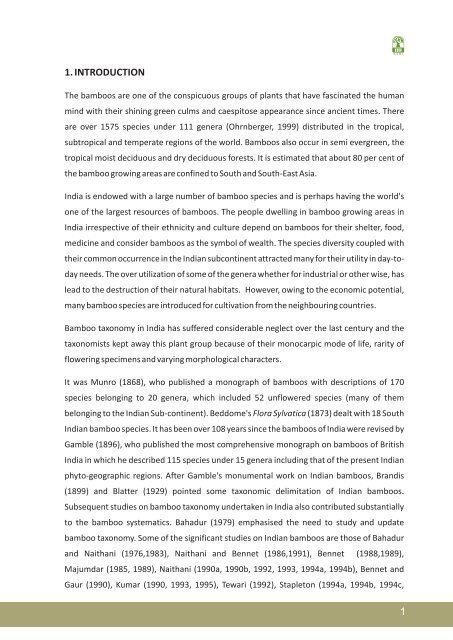Final report bamboo revisionary - Kerala Forest Research Institute
Final report bamboo revisionary - Kerala Forest Research Institute
Final report bamboo revisionary - Kerala Forest Research Institute
You also want an ePaper? Increase the reach of your titles
YUMPU automatically turns print PDFs into web optimized ePapers that Google loves.
K F R I<br />
1. INTRODUCTION<br />
The <strong>bamboo</strong>s are one of the conspicuous groups of plants that have fascinated the human<br />
mind with their shining green culms and caespitose appearance since ancient times. There<br />
are over 1575 species under 111 genera (Ohrnberger, 1999) distributed in the tropical,<br />
subtropical and temperate regions of the world. Bamboos also occur in semi evergreen, the<br />
tropical moist deciduous and dry deciduous forests. It is estimated that about 80 per cent of<br />
the <strong>bamboo</strong> growing areas are confined to South and South-East Asia.<br />
India is endowed with a large number of <strong>bamboo</strong> species and is perhaps having the world's<br />
one of the largest resources of <strong>bamboo</strong>s. The people dwelling in <strong>bamboo</strong> growing areas in<br />
India irrespective of their ethnicity and culture depend on <strong>bamboo</strong>s for their shelter, food,<br />
medicine and consider <strong>bamboo</strong>s as the symbol of wealth. The species diversity coupled with<br />
their common occurrence in the Indian subcontinent attracted many for their utility in day-today<br />
needs. The over utilization of some of the genera whether for industrial or other wise, has<br />
lead to the destruction of their natural habitats. However, owing to the economic potential,<br />
many <strong>bamboo</strong> species are introduced for cultivation from the neighbouring countries.<br />
Bamboo taxonomy in India has suffered considerable neglect over the last century and the<br />
taxonomists kept away this plant group because of their monocarpic mode of life, rarity of<br />
flowering specimens and varying morphological characters.<br />
It was Munro (1868), who published a monograph of <strong>bamboo</strong>s with descriptions of 170<br />
species belonging to 20 genera, which included 52 unflowered species (many of them<br />
belonging to the Indian Sub-continent). Beddome's Flora Sylvatica (1873) dealt with 18 South<br />
Indian <strong>bamboo</strong> species. It has been over 108 years since the <strong>bamboo</strong>s of India were revised by<br />
Gamble (1896), who published the most comprehensive monograph on <strong>bamboo</strong>s of British<br />
India in which he described 115 species under 15 genera including that of the present Indian<br />
phyto-geographic regions. After Gamble's monumental work on Indian <strong>bamboo</strong>s, Brandis<br />
(1899) and Blatter (1929) pointed some taxonomic delimitation of Indian <strong>bamboo</strong>s.<br />
Subsequent studies on <strong>bamboo</strong> taxonomy undertaken in India also contributed substantially<br />
to the <strong>bamboo</strong> systematics. Bahadur (1979) emphasised the need to study and update<br />
<strong>bamboo</strong> taxonomy. Some of the significant studies on Indian <strong>bamboo</strong>s are those of Bahadur<br />
and Naithani (1976,1983), Naithani and Bennet (1986,1991), Bennet (1988,1989),<br />
Majumdar (1985, 1989), Naithani (1990a, 1990b, 1992, 1993, 1994a, 1994b), Bennet and<br />
Gaur (1990), Kumar (1990, 1993, 1995), Tewari (1992), Stapleton (1994a, 1994b, 1994c,<br />
1

















